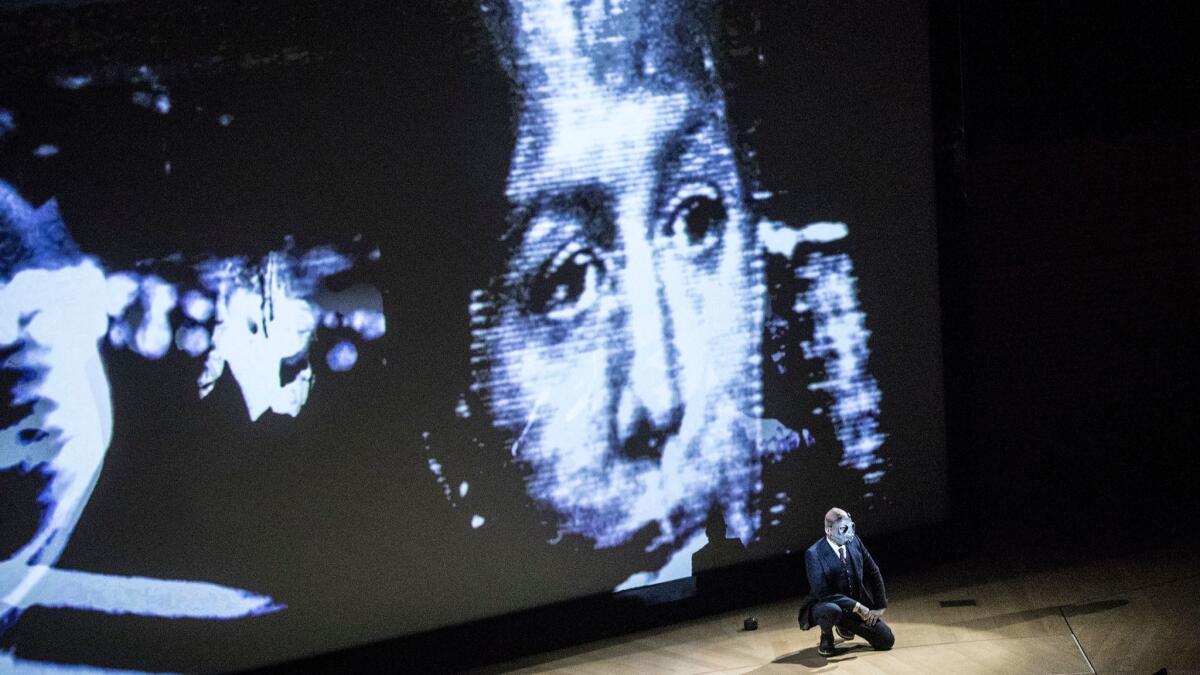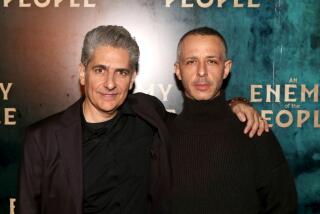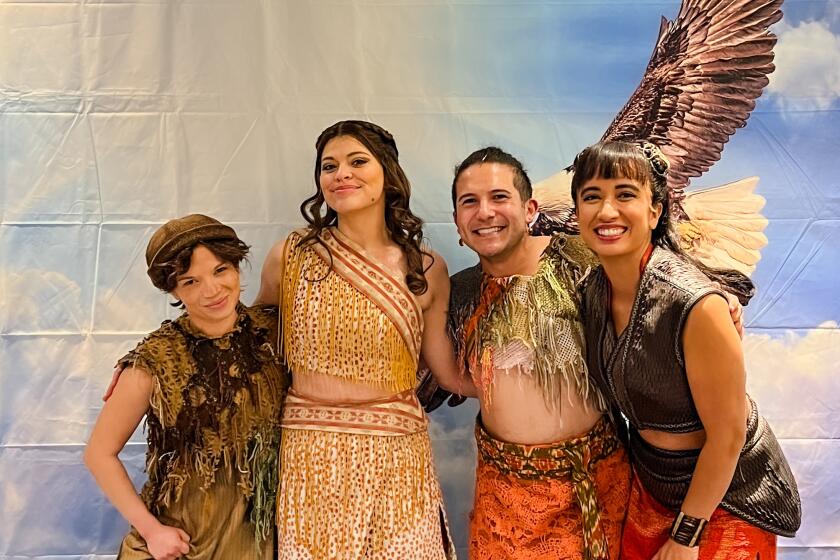Review: A Lincoln portrait, but this time with a gas mask, in Disney Hall

A “politico” in a three-piece suit and gas mask was expected to recite the Gettysburg Address under the influence of laughing gas at the Los Angeles Philharmonic’s Green Umbrella concert at Walt Disney Concert Hall on Tuesday night. The bodies of a couple of nude women on film were employed as the battlefield for war toys. Four pianists played a punishing piece with a startlingly title requiring an elaborate warning. And, heaven forbid, a harpist was, as supposed to be, heard over an imposing ensemble of brass and percussion.
What does this concert, devised by John Adams, have to do with the price of tea in China, or, for that matter, the bombs in Syria or the Black Lives Matter movement? A lot, it turns out.
Salvatore Martirano’s “L’s G.A. for Gas-Masked Politico, Helium Bomb, and Two-Channel Tape,” to give the full title of the piece that ended the program, is a blast from the 1968 past. It was written during a particularly contentious time, while the Vietnam War and protests against it raged. Martirano’s idea for a “politico” to inhale nitrous oxide (used as a stand-in for helium) before reciting Lincoln’s speech became a brilliant theatrical elicitation of a government out of control, of making what should make sense senseless.
The text would be mostly unintelligible if we didn’t know it so well. There is something profoundly unsettlingly about being able to pick Lincoln’s words out of a distortion enhanced by explosive electronic wails on the tape that accompanies the recitation, which is really amplified speech as song.
This being 2018, not 1968, marijuana may no longer be illegal, but there are apparently regulations about helium use in the concert hall. Performance artist Ron Athey’s voice was instead electronically altered, which worked sonically, although it meant he lost the ability to lose control. Behind him was the original experimental film created to accompany the score, a crazy-cut collage of abstraction and antiwar imagery — horrifying and, as with the nudes, whimsical (at least by the hippie standards of the times).
Julius Eastman — African American, militantly gay and alienated by the musical world at the time — wrote the provocatively titled “Evil Nigger” nine years earlier than “L’s G.A.,” and it is a shocking reminder of the roots of racial issues. Eastman had a meteoric rise as baritone, pianist and visionary composer and a tragic fall. He died in obscure poverty at age 49 in 1990, much of his work lost. But in the last couple of years, he has undergone so remarkable a revival that he seems about to turn into an outsider icon.
The performance was introduced with an archival recording of Eastman eloquently explaining his title at the 1979 premiere. He said he felt there was, for him, an elegant fundamentalism to a term that had become disabused. Of course, he knew full well that he was asking for, and wanting, trouble.

The work in question indeed asks for trouble, and it is amazing. Written for four or more melody instruments (Eastman used pianos because that’s what he had), it is a nearly indecipherable and somewhat Minimalist score with melodic lines of repeated notes and tremolos presented without instruction. The result is a work that shares many repetitious and harmonic aspects of the phase and pulse music that Philip Glass and Steve Reich were writing at the time, but Eastman adds an element of unpredictable ecstatic liberation.
It is almost as though the notes themselves are packed with helium. For an unrelenting 22 minutes, Dynasty Battles, Michelle Cann, Joanne Pearce Martin and Vicki Ray produced great piano waves that grew, crested and broke, each more exhilarating than the last. When it all ended, I had the sensation of a fundamental cause that could not be stopped.
In contrast, Andrew McIntosh’s “Shasta” might seem like an escape from it all. The piece was commissioned for the occasion, and Adams conducted members of the L.A. Phil New Music Group.
A violinist and violist who performs new music in wildUp and early music in Musica Angelica, McIntosh was inspired by his occasional retreats to Northern California’s mountains.
The 11 brass instruments echo what you might hear ascending Mt. Shasta. Scales that fall again and again, their timbres never remaining the same, uncannily evoke the beauty of vastness.
Meanwhile, given the necessity that Martirano and Eastman felt for musical violence, McInstosh’s unsentimental gentleness is what we now need. It proved deeply satisfying to witness boisterous brass comfortably settle into a sonic sofa, as if under orders from the plink of a harp, a plucked string from inside a piano or a soft tap from three unimposing percussionists.
The concert was to have begun with another world premiere by Katherine Young. But a sudden illness meant that the young Chicago composer and bassoonist was unable to play, requiring a postponement. The Los Angeles Percussion Quartet stepped up with Anna Thorvaldsdottir’s “Aura,” ethereal music played in the dark (with the players wearing lights on their hands).
More to Read
The biggest entertainment stories
Get our big stories about Hollywood, film, television, music, arts, culture and more right in your inbox as soon as they publish.
You may occasionally receive promotional content from the Los Angeles Times.







